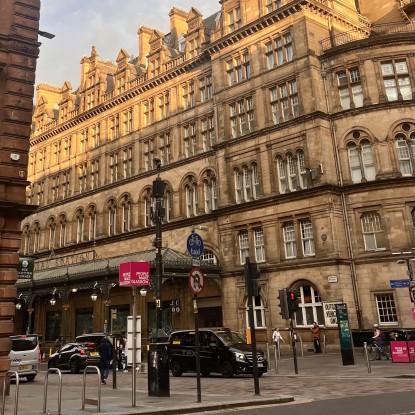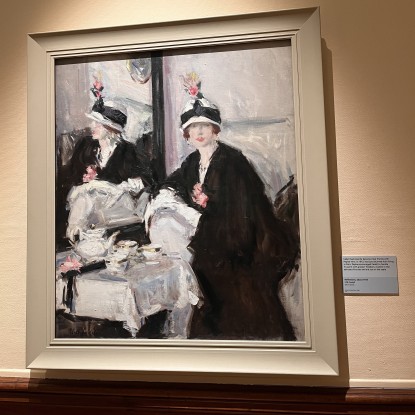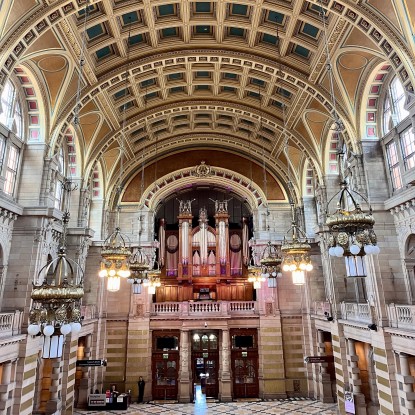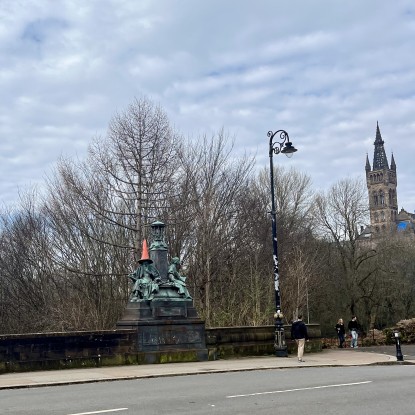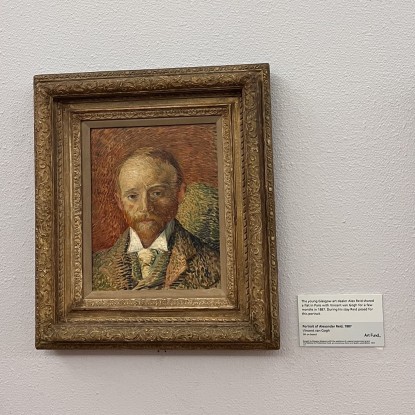Creatives Make Glasgow: 10 Pieces of Glaswegian Media I Consumed While Abroad
As you walk around Glasgow, hot pink signs claiming that “People Make Glasgow” will catch your eye on every block in the city. Whether it be on bikes, lampposts, trash cans, or stickers haphazardly adhered to the back of traffic signs, the city slogan is quite literally everywhere. I’ll admit, I was not entirely convinced at first. I mean don’t the majority of cities claim to have the best, most unique and charismatic people? However, after spending nearly six months in Glasgow, I have to agree with the slogan that the spirit and community Glaswegians have built in their city is one of the qualities that sets it apart from other places. As a studio art major and avid-reader, I was initially drawn to Glasgow because of the vibrant art scene deeply-rooted in history as well as the current day. With that in mind, I made an effort to engage with the work of Glaswegian creatives, primarily artists, authors, and musicians, throughout my time abroad. The list below is just a handful of the vast amounts of media that has either been created by Glaswegians, is set in Glasgow, or owned by a Glasgow institution.
Literature
- Eleanor Oliphant Is Completely Fine by Gail Honeyman
This was one of the novels that had been sitting on my to-be-read list for months, I was saving it for abroad to finally read. Not only is it set in Glasgow, but Gail Honeyman is from Stirling, a stunning historic city about 30 miles north, and also an alum of the University of Glasgow. One of the characters also has the last name “Lomond”, which possibly could be a reference to the nearby Loch Lomond just north of Glasgow. - Young Mungo by Douglas Stuart
Stuart, who grew up in Glasgow in the 1980s, draws upon experiences and observations from his youth to highlight themes of poverty, religious conflict, and organized violence in this Glasgow-set novel. The name of the main character, Mungo, is a reference to the patron saint of the city. Symbols of St. Mungo can be spotted throughout Glasgow and he is buried in the gorgeous Glasgow Cathedral. One of my favorite aspects of this book is the dialogue being phonetically written with a Glaswegian accent. As I spent more time around real people speaking with the accent, I was better able to fully understand the text. I was already familiar with Stuart’s work after having read his critically-acclaimed debut novel Shuggie Bain (also beautifully written and set in Glasgow) so I was looking forward to reading this novel and was not disappointed. - The Secrets of Blythswood Square by Sarah Sheridan
I picked this book up on a whim one day in Waterstones. It was towards the end of my time abroad, and I was feeling sentimental about nearly everything. So when I saw that the title of this book mentioned Blythswood Square, it made me think about how one of the buses I frequently rode stopped there and at the time that was reason enough for me to purchase. This historical fiction novel is set throughout Glasgow and Sheridan is from Edinburgh. - Honorable Mention: A Glasgow Kiss by Sophie Gravia
Truth be told, I have neither read nor purchased this book. But with that being said, the hot pink cover could reliably be found haunting at least one display table in every Waterstones throughout the city. I probably picked it up about ten different times throughout my months in Glasgow to read the blurb on the back, but never was quite convinced that it would be worth bringing home. The story could be fantastic and the best piece of fiction of this decade, or it could be truly terrible. Unless I have a sudden change of heart, I will likely never know. However, the mere persistence of the cover, similar in shade and spirit to that of the “People Make Glasgow” signs, makes it deserving of an honorable mention.
Art
- The Little Hills, c.1914-1915 by Margaret Macdonald Mackintosh
This art nouveau style art piece can be found in the Hunterian Museum at the University of Glasgow. Margaret Macdonald Mackintosh spent the majority of her life in Glasgow and is often highlighted as one of the members of the “Glasgow Girls” whose work heavily influenced what art historians now refer to as “The Glasgow Style”. Furthermore, her Glasgow-born husband, Charles Rennie Mackintosh, was an incredibly well regarded architect and artist. Both of them studied at the Glasgow School of Art alongside Margaret’s sister, Francis Macdonald, and Herbert MacNair. The four of them became known as the “Glasgow Four”. - Portrait of Alexander Reid, 1887 by Vincent Van Gogh
This painting in the Kelvingrove Art Gallery, a renowned museum only a short walk away from the University of Glasgow’s campus, is of Alexander Reid, a Glasgow art dealer. Reid was well-known in the art world in the late 1800s and some of the Scottish artists who are featured in the Kelvingrove were individuals who he worked with to sell their pieces. Van Gogh and Reid briefly lived together at various times during their respective careers. According to information provided by the Kelvingrove, this piece was rendered during the few months that they lived together in Paris. - Reflections, c.1915 by Francis Campbell Boileau Cadell (FCB)
Though Cadell was raised and educated in Edinburgh, not Glasgow, many of his pieces are exhibited in the Kelvingrove Art Museum. However, his ties to Glasgow do not end there, Alexander Reid (Yes, the same Alexander Reid that Van Gogh painted) curated Cadell’s first solo show in his gallery on St. Vincent Street in the city center. Cadell is considered to be an integral member of the Scottish Colourist movement. - The Druids - Bringing in the Mistletoe, 1890 by George Henry and Edward Atkinson Hornel
The final piece from the Kelvingrove on this list, the artists Henry and Hornel were both members of the Glasgow Boys. Though neither of them were born in Glasgow, they spent the majority of their careers working and exhibiting in the city. Furthermore, this piece draws upon themes found in ancient celtic art and folklore to combine a style of painting that was fairly revolutionary at the time with imagery rooted in tradition in cultures throughout Scotland. - Duke of Wellington, 1844 by Carlo Marochetti
This statue outside of the Gallery of Modern Art has taken on a personality of its own with some help from the people of Glasgow. The Duke nearly always has a traffic cone on top of his head. On occasion the cone has been changed to a different hat or accessory as commentary for a current event. The cone tradition, one that is not exclusive to the Duke of Wellington as I have seen many of the statues in Kelvingrove park donning fluorescent orange cones, is generally regarded as a reflection of the spirit of Glaswegians and the city as a whole.
Music
- Heaven or Las Vegas by Cocteau Twins
Technically, the band Cocteau Twins was not formed in Glasgow, but about 30 miles northeast in Grangemouth. So it is a bit of a cheat to add them to this list. However, they performed in Glasgow at various venues, including the iconic Barrowland Ballroom. In some roundabout way, the band’s name is also supposedly a reference to two men from Glasgow who have an affinity for Jean Cocteau. I already listened to the band prior to going abroad, so originally having them on my playlist was a coincidence. With that being said, when I learned of their local ties, I became more intentional about listening to them. - “Take Me Out” by Franz Ferdinand
While I do hear this song fairly frequently in the states, I felt like it was everywhere in Glasgow. Whether it was during pub quiz interludes or walking around Primark, there was no escaping this single by the Glasgow-based band. Eventually I decided to embrace hearing it all the time and “Take Me Out” was added to my running playlist.

